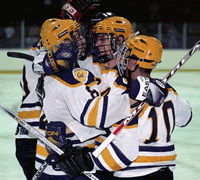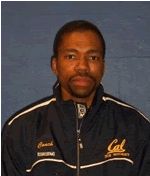August
22,
2004
Postcard:
Cable Cars in the Crease?
College hockey has a humble, hopeful home in
the Bay Area
By
Jess Myers
 |
| Cal
had plenty to celebrate in 2003-04, winning the Pac-8 title.
(Photo by Thomas Thompson) |
BERKELEY,
Calif. – Finding a college hockey venue within sight of
the Golden Gate Bridge isn’t as difficult as you might expect,
if you know where to look. Just a few blocks downhill from the
ridiculously scenic University of California campus in a residential
area sits Berkeley Iceland, home of the Cal Golden Bears and their
fledgling, but growing, club hockey program. In one of the most
liberal communities in the nation, Berkeley Iceland is about the
only place in town you'll find anything called a "right wing."
It stands
to reason that the lone ice rink in the community that gave us
Joe Kapp, Jason Kidd and the Free Speech Movement would be anything
but ordinary. Erected on a hillside overlooking San Francisco
Bay in 1940, Iceland is a winter palace akin to the old Broadmoor
World Arena in Colorado Springs, but with better sightlines. Built
to accommodate 4,000 figure skating spectators first and hockey
second, the Golden Bears home ice sheet is actually slightly larger
than Olympic size, at 102 by 202. Pinching your defensemen on
those endless bluelines is ill advised.
Unlike many
other warm-weather hockey programs, where the on-ice action is
dictated by a transplant from Minnesota, Michigan, Massachusetts
or Canada, the VIP in the Berkeley hockey community is locally
grown, so
to speak. Golden Bears coach Cyril Allen has lived in neighboring
Oakland all his life, but says that Berkeley Iceland has been
his real home by the Bay since he learned to skate in the days
when the NHL’s California Golden Seals played in his hometown
and practiced in Berkeley.
 |
| Cal
head coach Cyril Allen |
Wearing a
navy blue nylon top with the words “Cal Ice Hockey”
and “Coach” stitched on it in gold, Allen spends a
foggy Thursday evening directing practice for the Berkeley Bulldogs
pee wee team (he’s their head coach too), and takes a break
to talk about his teams while the Zamboni (invented just down
the coast in Paramount, Calif.) clears the ice. On October 1,
when the Golden Bears travel to UC-Davis for an exhibition game,
Allen will enter his fourth season behind the Cal bench and his
team will begin defense of the Pac-8 crown it won last February,
coming from behind in the third period to beat USC 3-2 in the
league’s title game.
The hockey
program at Cal, a member of the American Collegiate Hockey Association,
is mostly a student-fueled outfit, with sports marketing and business
majors getting internships worth college credits for their work
running and promoting the team. The players (most of whom are
native Californians) each pay $700 or more, plus travel expenses,
to wear the blue and gold each season. The Golden Bears practice
twice a week (usually late at night) and play a 36-game schedule
against the likes of San Jose State, Utah State, Brigham Young,
Long Beach State, and other ACHA teams.
Allen says
that despite the ocean-size ice sheet, his team and most of their
conference competition play a game that’s “more physical
than free-flowing.”
“I tell
players that the way to play this game is from the inside out,”
says Allen. “That means getting inside where the action
is, and getting inside the opponent’s jersey on defense.”
While the
Golden Bears have yet to approach a sellout for a home game, Allen
speaks with pride of the raucous 1,000 to 1,500 who show up each
November for the “Big Freeze” – the hockey counterpart
to the annual Big Game between the Cal and Stanford football teams.
In the days leading up to the football game, the Golden Bears
and Cardinal play a Thursday-Friday home-and-home hockey series
complete with bands, cheerleaders, and those cannons that shoot
t-shirts into the crowd.
Cal (along
with USC and UCLA) was briefly home to NCAA D-I hockey in the
1940s, and Allen says that each year at the Pac-8 meetings there
is some talk of the conference working toward moving up to D-III
and eventually D-I in the future. But Allen and his West Coast
counterparts are realistic enough to understand that several Pac-8
teams would have to make the move to varsity at the same time
if college hockey in California were to work this time, and that
move is still a long way off.
In the meantime,
for a hockey promoter in the Bay Area, there are small victories
to be savored. There has not yet been an influx of players from
Northern California advancing to D-I hockey and seeing the success
enjoyed by Southern Californians like Brett Sterling (Colorado
College), Gabe Gauthier (Denver) and Grant Goeckner-Zoeller (Princeton).
But Allen says that the growth of roller hockey, the popularity
of the San Jose Sharks, and the number of new ice sheets being
opened in the Bay Area has led to increasing numbers for hockey
programs there, and an boost in the number of Northern California
hockey players (male and female) getting noticed by junior teams
and small college programs.
“The
hockey community in Southern California is still much bigger than
what we’ve got here – more rinks, more bodies,”
Allen says. “So while it’s still unusual to see a
kid from the Bay Area go to a D-I program, kids from this region
are definitely being shown more interest in the college hockey
world.”
For more
information on Cal ice hockey or the ACHA, visit calicehockey.com
or achahockey.org.